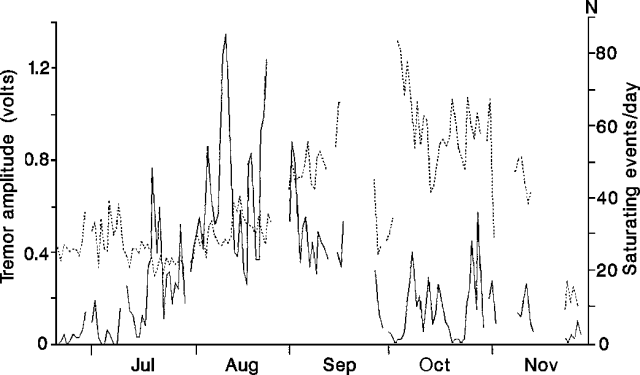Report on Stromboli (Italy) — October 1990
Bulletin of the Global Volcanism Network, vol. 15, no. 10 (October 1990)
Managing Editor: Lindsay McClelland.
Stromboli (Italy) Strong tephra ejection; increased seismicity
Please cite this report as:
Global Volcanism Program, 1990. Report on Stromboli (Italy) (McClelland, L., ed.). Bulletin of the Global Volcanism Network, 15:10. Smithsonian Institution. https://doi.org/10.5479/si.GVP.BGVN199010-211040
Stromboli
Italy
38.789°N, 15.213°E; summit elev. 924 m
All times are local (unless otherwise noted)
At the end of August, explosive activity in Crater 1 became nearly continuous and tremor amplitude increased. The monthly average tremor amplitude was twice as high in September as in August. The daily number of events that saturated seismometers oscillated around a mean of 30 until 20 September before rapidly decreasing (figure 9). Saturating events and tremor amplitude reached a minimum during the first week in October, then remained at levels similar to those preceding the strong activity in the second half of July.
 |
Figure 9. Number of seismometer-saturating events/day (solid line); and average tremor amplitude (dashed line) at Stromboli, mid-June to November 1990. Courtesy of M. Riuscetti. |
Volcano guides reported the following activity. 1-6 September: Ejection of hot lapilli was continuous from vents 1 and 2 in crater C1 (figure 10). Violent explosions with ash emission (150-200 m high) occurred from C3. 7-12 September: Activity was similar from C1 and C3. Block ejection and gas emission took place from C2. 13-20 September: Ejection of hot lapilli and noisy gas emission occurred from C1, while continuous minor explosions ejected small blocks from C2. Tephra was filling C3, where 4 new vents were forming on 15 September. 21 September-4 October: Most activity was concentrated in C1 and C3, with frequent explosions ejecting hot lapilli to as high as 200 m.
 |
Figure 10. Sketch from "Pizzo sopra la Fossa" looking NW at the summit of Stromboli, October 1990. Courtesy of M. Riuscetti. |
Geologists visited the summit area 4-10 October. The activity was more vigorous than had been seen during 25 years of study at Stromboli. Strong explosions at 15-20-minute intervals fed powerful brown ash emissions that reached about 300 m height (from vent 4 of C3). Nearly continuous bomb ejection from vent 1 of C1 was evident at night and gases were red. Stronger explosions were synchronous from many of the vents in the 3 craters. Lava spilled out every few tenths of a second from one small cone (1) in C3. One vent (3) in C1 ejected gas nearly every second. Fumarolic activity was very intense, especially from the W rim of C3. At least 3 new vents had formed (3 in C1 and 2 & 3 in C3) with continuous whistling and rare explosions.
11-16 October: Activity continued, but with an apparent slight decline. 17-28 October: Observations from the summit area were not available, but seismicity and reports from a village at the foot of the volcano suggested decreasing activity.
Geological Summary. Spectacular incandescent nighttime explosions at Stromboli have long attracted visitors to the "Lighthouse of the Mediterranean" in the NE Aeolian Islands. This volcano has lent its name to the frequent mild explosive activity that has characterized its eruptions throughout much of historical time. The small island is the emergent summit of a volcano that grew in two main eruptive cycles, the last of which formed the western portion of the island. The Neostromboli eruptive period took place between about 13,000 and 5,000 years ago. The active summit vents are located at the head of the Sciara del Fuoco, a prominent scarp that formed about 5,000 years ago due to a series of slope failures which extends to below sea level. The modern volcano has been constructed within this scarp, which funnels pyroclastic ejecta and lava flows to the NW. Essentially continuous mild Strombolian explosions, sometimes accompanied by lava flows, have been recorded for more than a millennium.
Information Contacts: M. Riuscetti, Univ di Udine.

